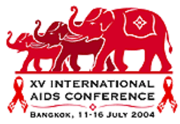 |
 |
 |
| |
NEW NNRTI 695634: safety, PK, tolerability in healthy subjects
|
| |
| |
|
|
| |
| |
 |
|
| |
| |
RReported by Jules Levin
GlaxoSmithKline researchers reported on a new NNRTI in a poster at the XV Intl AIDS Conference in Bangkok, Thailand (July 2004). 695634 is a prodrug of the active compound 678248, a new NNRTI in development for treating HIV. 678248 is active in vitro, in the test tube, (IC50≤2 nM) against NRTI-resistant mutants and NNRTI-resistant mutants (IC50≤7 nM). In a panel of isolates from NNRTI-experienced patients that showed efavirenz and/or nevirapine resistance, >80% of the viruses were susceptible to 678248 with ≤10 fold change in IC50 value. This prodrug has the potential to be an effective therapeutic option for treatment-experienced patients.
The poster reported on a study designed to:
--establish initial safety, tolerability and PK of 695634 and 678248 in healthy subjects.
--study the effect of food on the relative bioavailability of 695634 and 678248
--support the dose selection for future clinical studies.
The study enrolled healthy male subjects in a double-blind, randomized, parallel, placebo-controlled, single-ascending dose study of 695634. Study doses were 10mg, 25mg, 75mg, 200mg, 400mg, 600mg, and 800mg. At each dose level, 10 subjects were enrolled with 8 receiving 695634 and 2 receiving placebo. To study the effect of food on the relative bioavailability of 695634 and 678248, the 200mg dose was given on a second occasion with a standard high fat meal.
RESULTS
SAFETY
Study authors reported that 695634 was generally well tolerated. No SAEs, deaths, or withdrawals due to AEs occurred during the study. The most commonly reported AEs were rash (14 subjects; 18%), headache (10 subjects; 13%), erythema (8 subjects; 11%), skin irritation (5 subjects; 7%), skin laceration (4 subjects; 5%), pharyngolaryngeal pain (4 subjects; 5%), and increased serum ALT values (4 subjects; 5%). Authors reported that the subjects who experienced rash (14 subjects), erythema (8 subjects), and skin irritation (5 subjects) had these due to ECG electrode site irritation and not due to the drug in the opinion of the investigator.
All AEs were reported mild to moderate in intensity; no severe AEs were reported; no notable trends in AEs were observed with increasing doses of 695634. No notable trends in laboratory values were observed.
Changes from placebo in QTc were generally small (-4.436 to +2.161 msec) for the overall population. There were no QTc, QTcF, QTcB, or QTcl abnormalities of >60 msec duration.
PHARMACOKINETICS
695634 was rapidly converted and absorbed as 678248 with a median Tmax of about 1.00 to 3.75 hours, and 10-18 hour half-life. The relative exposure of 695634 to 678248 was very low (ratio of geometric LS mean range 0.0-1.4% for AUC[0-∞] and 2.6 to 9.6% for Cmax). Both 678248 and 695634, AUC (0-∞), and Cmax values increases were observed with dose. Greater proportional increases were observed with 800mg dose for 678248 and for doses ≥400mg for 695634 when compared to the 200mg dose. 678248 half-life appeared to increase with dose. Food increased geometric LS mean 678248 AUC (0-∞) by 17% (mean ratio: 1.17; 90% CI: 0.88, 1.56) and Cmax by 31% (mean ratio: 1.31; 90% CI: 0.86, 1.98); but, decreased 695634 AUC (0-∞) by 42% (mean ratio: 0.58; 90% CI: 0.22, 1.56) and Cmax by 49% (mean ratio: 0.51; 90% CI: 0.20, 1.32). Authors concluded 695634 can be administered with or without food.
Poster reported a repeat-dose study has been completed to further characterize the PK and safety of 695634 and 678248. A study to further evaluate the clinical efficacy of 695634 for use in the treatment of HIV-infected patients has been initiated in NNRTI-experienced patients.
|
| |
|
 |
 |
|
|